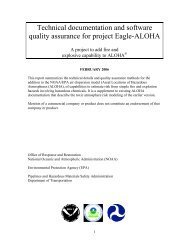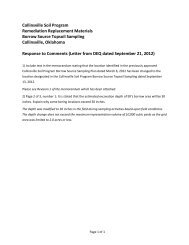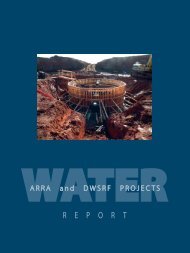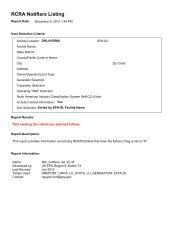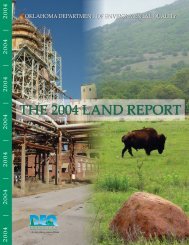Oklahoma Gas & Electric Muskogee Generating Station Best ...
Oklahoma Gas & Electric Muskogee Generating Station Best ...
Oklahoma Gas & Electric Muskogee Generating Station Best ...
You also want an ePaper? Increase the reach of your titles
YUMPU automatically turns print PDFs into web optimized ePapers that Google loves.
<strong>Oklahoma</strong> <strong>Gas</strong> & <strong>Electric</strong><br />
<strong>Muskogee</strong> <strong>Generating</strong> <strong>Station</strong> – BART Determination<br />
May 28, 2008<br />
term boiler NOx emissions will be higher under certain operating conditions. Furthermore,<br />
the mechanisms used to reduce NOx formation (e.g., cooler flame and reduced O2<br />
availability) also tend to increase the formation and emission of CO and VOCs.<br />
Based on information available from burner control vendors, emissions achieved in practice<br />
at existing similar sources, and engineering judgment, it is expected that combustion<br />
controls, including LNB and OFA, on the tangentially-fired <strong>Muskogee</strong> boilers can be<br />
designed to meet the presumptive NOx BART emission rate of 0.15 lb/mmBtu<br />
(approximately 110 ppmvd @ 3% O2). An average emission rate of 0.15 lb/mmBtu should<br />
be achievable on a 30-day rolling average basis under all normal boiler operating<br />
conditions and while maintaining acceptable CO and VOC emission rates.<br />
3.2.1.2 Flue <strong>Gas</strong> Recirculation<br />
Flue gas recirculation (FGR) controls NOx by recycling a portion of the flue gas back into<br />
the primary combustion zone. The recycled air lowers NOx emissions by two mechanisms:<br />
(1) the recycled gas, consisting of products that are inert during combustion, lowers the<br />
combustion temperatures; and (2) the recycled gas will reduce the oxygen content in the<br />
primary flame zone. The amount of recirculation is based on flame stability.<br />
FGR control systems have been used as a retrofit NOx control strategy on natural gas-fired<br />
boilers, but have not generally been considered as a retrofit control technology on coalfired<br />
units. Natural gas-fired units tend to have lower O2 concentrations in the flue gas and<br />
low particulate loading. In a coal-fired application, the FGR system would have to handle<br />
hot particulate-laden flue gas with a relatively high O2 concentration. Although FGR has<br />
been used on coal-fired boilers for flue gas temperature control, it would not have<br />
application on a coal-fired boiler for NOx control. Because of the flue gas characteristics<br />
(e.g., particulate loading and O2 concentration), FGR would not operate effectively as a<br />
NOx control system on a coal-fired boiler. Therefore, FGR is not considered an applicable<br />
retrofit NOx control option for <strong>Muskogee</strong> Units 4 & 5, and will not be considered further in<br />
the BART determination.<br />
3.2.2 Post-Combustion Controls<br />
Post-combustion NOx control systems with potential application to <strong>Muskogee</strong> Units 4 & 5 are<br />
discussed below.<br />
3.2.2.1 Selective Non-Catalytic Reduction<br />
Selective non-catalytic reduction (SNCR) involves the direct injection of ammonia (NH3)<br />
or urea (CO(NH2)2) at high flue gas temperatures (approximately 1600ºF - 1900ºF). The<br />
13



